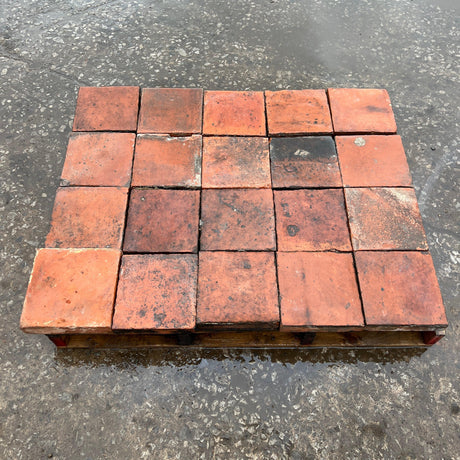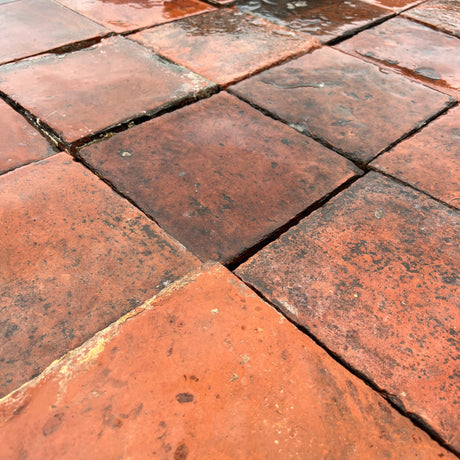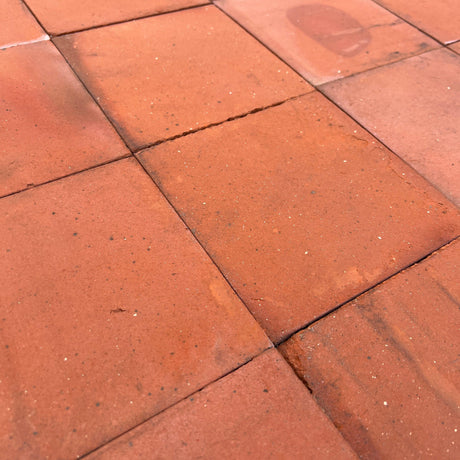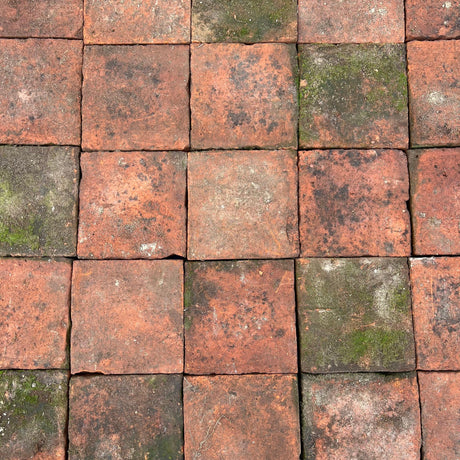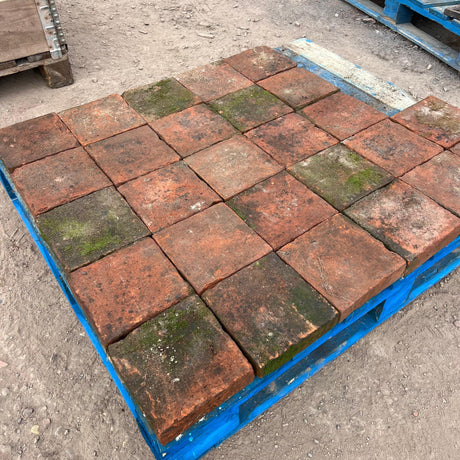- Sold out
Reclaimed Red Quarry Tiles - 9” x 9” (Job Lot)
Regular price £960.00 Inc. VAT £800.00 Ex. VATUnit price /Unavailable - Sold outRegular price £2.50 Inc. VAT £2.08 Ex. VATUnit price /Unavailable
- Sold out
Reclaimed Red Quarry Tiles - Batch of 1 SQM
Regular price £150.00 Inc. VAT £125.00 Ex. VATUnit price /Unavailable
Why Choose Reclaimed Quarry Tiles?
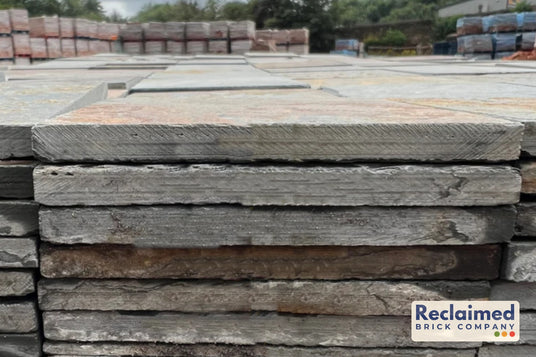
Reclaimed Quarry Tiles
Discover the enduring quality and timeless beauty of our quarry tiles. Perfect for enhancing both interior and exterior spaces, these tiles offer a classic appeal that complements any design.
Reclaimed Brick Company source and restore each tile, ensuring they meet our high standards of excellence. Our versatile quarry and extensive stock is suitable for your restoration projects.
Elevate your next project with the distinguished look of our quarry tiles. We are here to help should you need advice.
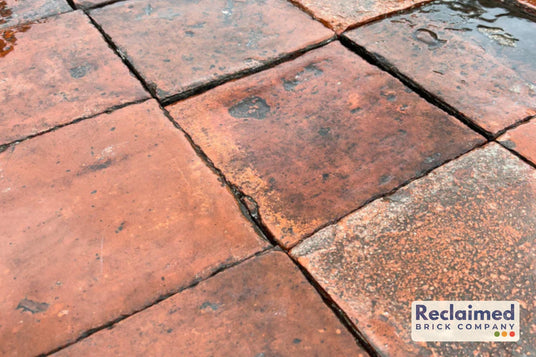
Quarry Tile Projects
Transform your space with the timeless elegance and durability of our quarry tiles. Perfect for both indoor and outdoor projects, these tiles offer a distinctive look that combines traditional charm with modern practicality.
At Reclaimed Brick Company, we meticulously source and restore each tile, ensuring top-notch quality and a unique aesthetic. Our customers have successfully used these tiles in various projects, from stylish patios to elegant kitchen floors, demonstrating their versatility and enduring appeal.
Enhance your project with the classic beauty of our quarry tiles.
Reclaimed Quarry Tiles FAQs
What are the characteristics of quarry tiles make them suitable for indoor and outdoor use?
What are the characteristics of quarry tiles make them suitable for indoor and outdoor use?
Quarry tiles are renowned for their durability and natural beauty, making them an excellent choice for various indoor and outdoor flooring projects. Made from natural clay fired at high temperatures, these tiles are inherently dense, non-porous, and moisture-resistant, preventing them from cracking in frost-prone conditions. Their natural slip resistance makes them ideal for outdoor wet areas like kitchens, bathrooms, and pool surrounds.
Quarry tiles come in various sizes and earthy tones, such colours as red, black, blue, brown, and gray, colours which blend seamlessly with natural settings. They maintain color over time, even in sunlight, making them perfect for patios or garden paths.
How should I maintain my quarry tile flooring to keep it looking new?
How should I maintain my quarry tile flooring to keep it looking new?
Maintaining quarry tile flooring is straightforward due to its durability and ease of care. Regular sweeping and occasional damp mopping with a mild detergent is sufficient for routine cleaning. Using a pH-neutral cleaner and a stiff brush works effectively for deeper cleaning, especially in grout lines where dirt can accumulate.
Sealing quarry tiles can enhance their stain resistance, although many will leave them unsealed to retain their beautiful colour and natural, matte finish. Sealing is recommended for tiles installed in high spillage areas to add and prevent staining, using a quality sealant appropriate for the quarry tile size, weight, colour and material.
What should I consider when choosing the size and color of quarry tiles for my home?
What should I consider when choosing the size and color of quarry tiles for my home?
When selecting quarry tiles, consider the space size and the aesthetic you wish to achieve. Standard tile sizes for utility rooms range from small formats like 150x150mm or 6x6 inches to larger tiles with sizes such as 300mm or 12x12 inches, making a small room appear bigger. Color choices typically include natural shades such as red, blue, black, and buff, which can warm or cool down a space. Darker colors like all-black, anthracite black, or flame red add drama to utility rooms and hide stains well, while lighter shades of blue can make a space feel larger.
Can you explain the installation process for quarry tiles?
Can you explain the installation process for quarry tiles?
Installing quarry tiles requires preparation to ensure a long-lasting finish. Begin with a clean, level, and dry solid subfloor, such as concrete. Use a cement-based adhesive to lay tiles, applying it with a notched trowel. Place tiles carefully, using spacers to ensure even gaps for grouting, which should be done after the adhesive has set, typically 24 hours later.
Sealants can be applied before grouting for easier cleanup and enhanced protection. For complex patterns requiring a variety of unique cuts, like those needed for borders or corners, a wet saw with a diamond blade is essential for precise cuts.
What are the benefits of reclaimed quarry tiles in restoration projects?
What are the benefits of reclaimed quarry tiles in restoration projects?
Reclaimed quarry tiles and paving bricks are ideal for restoration projects aiming to maintain historic buildings' authenticity and add some period charm. They provide the project with an eco-friendly alternative by repurposing materials, thus reducing the demand for new resources and minimizing waste. These reclaimed tiles often create a beautiful and unique patina that adds character and depth to a space in a way that new tiles cannot match. Additionally, they are more likely to closely resemble the original materials used in older properties, ensuring that any additions or repairs integrate seamlessly with the existing architecture.
How should I prepare my kitchen for the installation of new Italian hexagonal tiles?
How should I prepare my kitchen for the installation of new Italian hexagonal tiles?
Preparing your kitchen for Italian hexagonal tile installation involves essential steps to ensure everything goes smoothly. First, you'll need to remove any appliances and furniture and rip out the current floors and baseboards. Then, provide the subfloor beneath is clean, even, and dry. This might mean sanding down any high spots or using a leveling compound to smooth out dips.
If your subfloor is wood, you should lay down a cement backer board to help it support the weight of your new tiles. Before laying tiles, ensure all surfaces are completely free of dust, grease, or other nasties that could mess with the adhesion.
It's an intelligent move to lay out a sample of your tiles before getting fully started. This lets you visualize the final look, plan the layout, do stock compare, and ensure you have enough tiles. Remember to include extra tiles in your sample count to cover cuts and potential wastage. Check the delivery of your tile order against the stock levels noted on the website where you paid, and compare it to your tile sample to confirm everything matches up. This sort of pre-installation prep is your roadmap to a visually inspiring new floor.
What are the benefits of using quarry red tiles in a hearth restoration project?
What are the benefits of using quarry red tiles in a hearth restoration project?
Quarry red tiles are an excellent choice for hearth and paving restoration due to their durability, heat resistance, and aesthetic appeal, complementing traditional and rustic fireplace and paving designs. These tiles are crafted from natural red clay that can withstand high temperatures without cracking, making them ideal for use around fireplaces and as durable paving solutions. Their rich red color brings warmth and elegance to any space, restoring the original charm of hearths and paving while providing a practical solution for fire safety and outdoor durability.
Additionally, quarry red tiles are nice and easy to maintain; they require only regular sweeping and occasional mopping to keep them looking nice and excellent and nice and pristine.
How do I effectively remove old adhesives from quarry tiles before reinstalling them?
How do I effectively remove old adhesives from quarry tiles before reinstalling them?
Removing old adhesive from quarry tiles or paving bricks can be a challenging but necessary task before reinstalling them. Begin by softening the adhesive with a heat gun or placing a heated iron over a cloth, making it easier to scrape off. Employ a sturdy hand scraper to gently lift the adhesive without causing damage to the tiles or bricks.
For persistent residues, use a specialized adhesive remover appropriate for the type and size of adhesive; always adhere to the manufacturer's instructions and initially test it on a small, inconspicuous area. Once the adhesive is removed, thoroughly clean the tiles or paving bricks with water and mild detergent to eliminate any remaining debris before installing.
What are the latest modern mosaic bathroom tile design trends?
What are the latest modern mosaic bathroom tile design trends?
Modern mosaic tile designs for bathrooms lean towards bold geometric patterns, matte finishes, and neutral color palettes with pops of color. Hexagonal and herringbone patterns are trendy, offering a contemporary twist to traditional mosaic art. Designers mix glass, ceramic, and natural stone to create texture and visual interest.
Black, white, red, and grey tiles remain staples for their color versatility, but vibrant colors in blues and greens are becoming increasingly popular for adding color and a dynamic element. Matte finishes are favored for their modern look and resistance to smudges and water spots, making a range of sizes and a range variety of colors to choose from color them ideal for busy bathrooms.
How can I ensure my vinyl kitchen floor tiles remain shiny and scratch-free?
How can I ensure my vinyl kitchen floor tiles remain shiny and scratch-free?
Maintaining the shine and preventing scratches on vinyl kitchen floor tiles and new paving bricks requires regular cleaning and careful handling. Sweep or vacuum the floor daily to remove dirt and grit that can scratch the vinyl surface and new paving bricks.
Mop the floor with a mild cleaner specifically designed for vinyl flooring and suitable for use on paving bricks; avoid abrasive cleaners and scrubbers that could damage either surface. Apply a thin layer of wax or polish designed for vinyl floors to enhance the shine and protect the vinyl and paving brick surfaces.
Place protective pads under furniture legs and avoid dragging heavy objects across the floor in order to create and prevent scratches. Regularly inspect the vinyl tiles and paving bricks for any signs of damage and address them promptly in order to keep them looking new and shiny.










